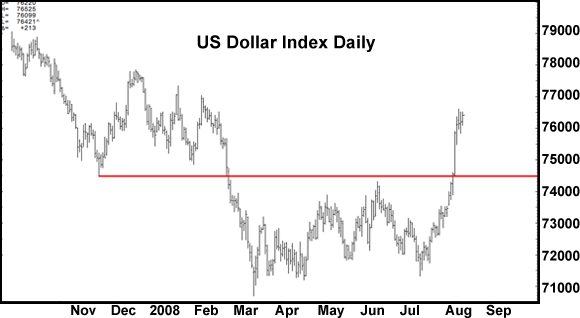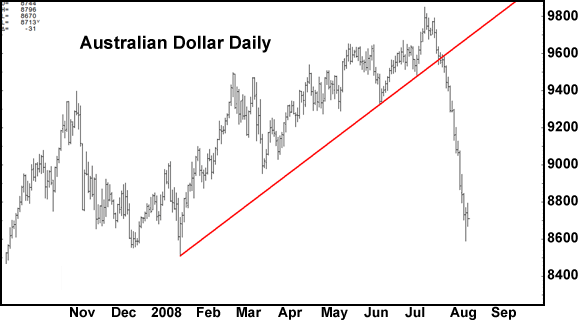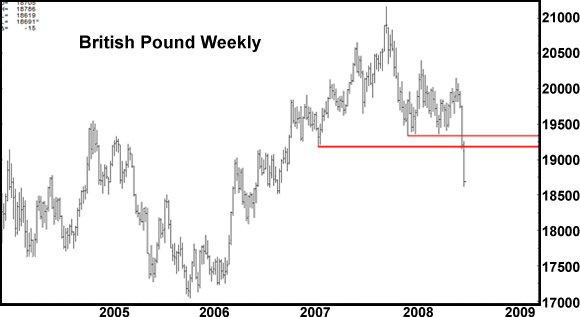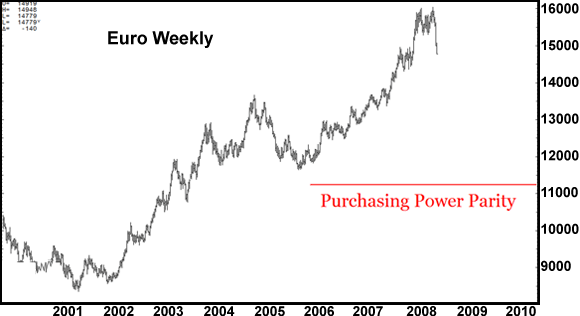US Dollar's Dramatic Rise Helps Level Currency Playing Field
Currencies / Forex Trading Aug 17, 2008 - 04:05 PM GMT Jack Crook writes: After a dramatic two weeks in the currency market, I figured now is a good time to run through the recent action. Plus, I'll give you my outlook for the major currencies making the most noise. Let's get started ...
Jack Crook writes: After a dramatic two weeks in the currency market, I figured now is a good time to run through the recent action. Plus, I'll give you my outlook for the major currencies making the most noise. Let's get started ...
A Good Couple of Weeks for the Buck
I'll keep it simple: The U.S. dollar and the U.S. economy have undergone no structural changes. Their relatively improved status seems to rest mostly on the worsening state of their major competitors — especially the euro.
It's a relative game, and the momentum has shifted. A chart of the U.S. dollar index speaks volumes:

What you're looking at here is a hugely bullish breakout.
Perhaps the recent meeting of multiple monetary policy committees — RBA, FED, BOE and ECB — stirred the pot enough to spark a dollar rally. Perhaps it was the erupting conflict between Russia and Georgia that buoyed what I still emphatically consider the world's reserve currency. Perhaps commodity prices falling out of bed had something to do with the greenback's strength.
But right now I would expect a period of consolidation is in order; even a pullback to key resistance-turned-support, as I marked with a red horizontal line in the previous chart. After that I expect the next leg higher to take the buck to at least the 78000 range.
And here's what I'm expecting from some of the other major currencies out there ...
High-Yielders Showing High Drawdowns
It doesn't seem to be so much a risk-aversion play anymore. Instead, it simply goes to what I've been talking about a lot lately — the relative game of currencies. High-yielding currencies — particularly the Australian and New Zealand dollars — did well in an environment where U.S. growth and interest rates declined.
But the New Zealand dollar has had a rough go of it since the beginning of the year. That's when prospects for continued growth and climbing interest rates began to level off. Unfortunately, it's only going to get tougher for New Zealand. The Reserve Bank of New Zealand recently cut interest rates. And the central bank revealed the need for further cuts to bail out the economy.
The Australian dollar, on the other hand, reached a 26-year high versus the U.S. dollar just over a month ago. But it's literally been downhill from there. This chart tells the story:

That's quite a drop, even for a fast-moving currency like the Australian dollar. Besides a bearish technical chart set-up, the avalanche got moving with comments from the Reserve Bank of Australia. Basically, the economy isn't doing so hot anymore.
In fact, we recently learned that a major Australian bank has to write down billions of dollars in losses related to CDOs. That's the same thing that got the U.S. credit crunch rolling. At the same time, falling commodity prices and a somewhat slower China put further pressure on the Australian economy into year-end.
The Going Gets Tougher for the British Pound
In the past, I've outlined the major factors undermining the British pound. So I'll be brief. Growing levels of debt, consumer pessimism, housing bust, rising unemployment and the need for interest rate cuts all bode ill for the pound.
Looking at a chart, things aren't any brighter ...

Two major long-term support levels have fallen in as many weeks. There's still a long ways to slide and few areas of support along the way.
A level right around $1.70 is where my ultimate target lies. It will likely take several months before it reaches this point, but at the current rate of roughly 10 cents every two weeks, we could see $1.70 per pound by September!
And while the potential for the pound to collapse is huge, there's a good chance we'll see another major European currency be dismantled ...
The Euro: When It Rains, It Pours
Without a doubt, the euro's benefited most from the dollar's long-term bear market. As a dollar alternative, the euro rose to more than $1.60 in the face of rising commodities, whirling credit conditions, and inflation.
But global market dynamics are shifting, and seemingly out of the euro's favor. I see two big reasons:
Reason #1: Crude Oil Reeling
Having risen in sync with crude oil prices, the euro is at risk as oil falls back towards a more fairly valued price. Simply put: Demand for oil was strong and seen only to be growing stronger; the European Central Bank was in the minority standing firm on monetary policy, fighting inflation. The resulting strong interest rate policy drove the euro to record levels.
The crude oil story is now changing, and changing fast. Demand for gasoline is falling. Motorists in the U.S. drove 12 billion fewer miles in June from the same month a year ago. This is the eighth straight month of declines and the worst drop since the oil shock of the 1970's.
Likewise, demand for crude oil is falling. On top of that, supplies of crude coming out of key OPEC countries are growing. And the downshift in oil prices is happening so quickly because few people expected this shift was even possible.
Reason #2: Ongoing Economic Struggles
When it comes to real estate conditions, the U.S. market has remained squarely under the global microscope. The U.K. market was soon put in the same position. Scrutiny revealed major problems in each market.
But in the background stood a quietly deteriorating group of European countries whose real estate markets simply stunk. Many of these countries showed more outlandish mortgage debt ratios than in the U.S. and U.K.
And fresh on the economic front have been declines in service and manufacturing indices. Sentiment among consumers and business has become abysmal. Exports are being impacted by the U.S. slowdown, not to mention the less severe, but still significant, slowdown in China that's surely playing a role.
The newest piece of information shows us that the Eurozone GDP, on a quarter-over-quarter basis, actually contracted in the second quarter. GDP sank 0.2% in the second quarter after growing 0.7% in the first quarter. The pressure is now on the Eurozone to avoid two-consecutive quarters of contraction that would put them, technically, in a recession. Meanwhile, the U.S. and the U.K. are coming off quarters of GDP growth.
Ultimately these two forces could push the euro much, much lower. Here's one thing to keep in mind — have a look at this chart:

The euro could fall to roughly $1.12, or a level that I've marked as "purchasing power parity" in the above chart. That's where each currency affords the same basket of goods in its home country.
And while this target is a good ways off on the horizon, it's not unreasonable to expect the euro could move this low over the next 12-18 months, driven largely by a widespread dollar rally and relatively worse news outside of the U.S.
But something to keep in mind ...
While upping his concern for the euro economy, European Central Bank President Trichet has maintained his focus on rising prices. The latest predictions of analysts and economists, however, point towards inflation having already peaked, mostly since oil prices have dropped off sharply from all-time highs.
Still, Trichet and other ECB members may have to consider the chances for wage inflation spiraling beyond comfort levels.
Again, if the Euro area economy bounces back — due to easing energy and commodity pressure or whatever — and unemployment levels remain stable, workers could find a window of opportunity to demand higher wages, which eventually would push up costs of production and final goods prices.
This is something Trichet feels he must avoid. And this is something that will need to be considered going forward as traders shift out of euros and into dollars quite hurriedly.
It's definitely the dollar's time to shine. I think it will. But as the year winds down, this is one of many obstacles that could jump into the headlines challenging a major dollar recovery.
Best wishes,
Jack
This investment news is brought to you by Money and Markets . Money and Markets is a free daily investment newsletter from Martin D. Weiss and Weiss Research analysts offering the latest investing news and financial insights for the stock market, including tips and advice on investing in gold, energy and oil. Dr. Weiss is a leader in the fields of investing, interest rates, financial safety and economic forecasting. To view archives or subscribe, visit http://www.moneyandmarkets.com .
Money and Markets Archive |
© 2005-2022 http://www.MarketOracle.co.uk - The Market Oracle is a FREE Daily Financial Markets Analysis & Forecasting online publication.



